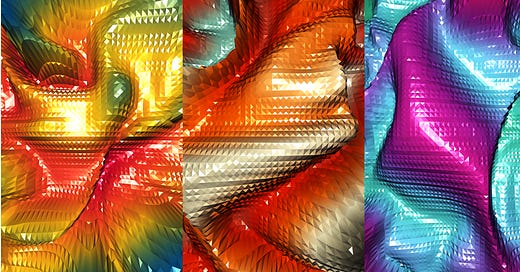When a machine makes it, is art still Art?

FluidScapes — by Reza Ali at CODAME Art by Code (2014 ) — Metal Prints, C++ & openFramework
Staring at some reputed masterpieces of modern art and at some images produced by A.I. systems, many lay people prefer the latter. Many people think that the art produced by the machine is more beautiful than the art made by humans and certified by art historians, galleries and museums (not to mention wealthy collectors). Many people even confess that they feel moved by the art produced by the machine. That is, of course, until someone tells them that the art was made by a machine.
This prompts several questions
“What is Art?” Is it Art only if it is made by humans? Can animals, rivers and machines also make Art? Who decides what is Art and what is not?
“Who made the art?” Human beings designed and implemented the A.I. system that produced the art: who should take credit for the art?
What is fundamentally different between an A.I. system and traditional software? We don’t think of our email system as a system that “writes” emails, but simply as a tool to write emails. At which point does software become a subject rather than an object?
What is the difference between a conscious mind and a tool that can be as creative as the conscious mind?
As machines become more creative, how does our relationship with them change?
Explore this questions with Piero Scaruffi, a cultural historian and a veteran of Artificial Intelligence, moderates a panel with roboticist/artist Alexander Reben, art critic Meredith Tromble, and philosopher John Campbell at this year’s CODAME ART+TECH Festival, codenamed #ARTOBOTS. June 7, Thursday, 1.30pm-2.30pm at The Midway, San Francisco.

Piero Scaruffi is a cultural historian who has lectured in three continents and published several books on Artificial Intelligence and Cognitive Science, the latest one being “The Nature of Consciousness” (2006). He pioneered Internet applications in the early 1980s and the use of the World-Wide Web for cultural purposes in the mid 1990s. His poetry has been awarded several national prizes in Italy and the USA. His latest book of poems and meditations is “Synthesis”(2009). As a music historian, he has published ten books, the latest ones being “A History of Rock and Dance Music” (2009) and “A History of Jazz Music” (2007). His latest book of history is “A History of Silicon Valley” (2011). The first volume of his free ebook “A Visual History of the Visual Arts” appeared in 2012. His latest book is “Intelligence is not Artificial” (2013). He has also written extensively about cinema and literature. He founded the Leonardo Art Science Evening Rendezvous (LASER) in 2008 and the Life Art Science Tech (LAST) festival in 2014. Since 2015 he has been commuting between California and China, where several of his books have been translated.

Meredith Tromble is an artist and writer who has worked in “in-between” spaces throughout her career: mixing drawing, performance, and installation; writing about her own creative process and the work of others; and engaging crossover points between art and science. She has been artist-in-residence at the Complexity Sciences Center at the University of California, Davis (UCD), since 2011. Her ongoing collaboration with UCD geobiologist Dawn Sumner, the interactive 3-D art installation “Dream Vortex,” has been presented internationally at ISEA2015, Vancouver and Creativity & Cognition, Glasgow School of Art, 2015, and nationally at more than a dozen public lectures at American universities ranging from Stanford University in Palo Alto to Brown University in Providence. A related dance performance “The Vortex,” a collaboration with choreographer Donna Sternberg, will debut at The Odyssey in Los Angeles April 20–21, 2018. Tromble is also the co-editor, with Charissa Terranova, of “The Routledge Companion to Biology in Art & Architecture; editor of “The Art and Films of Lynn Hershman Leeson,” from University of California Press; and author of hundreds of short form writings on art including a paper for the Artnodes Journal special issue on Art & Research, Winter, 2018.

Alexander Reben is an artist and roboticist, who explores humanity through the lens of art and technology. His work deals with human-machine relationships, synthetic psychology, artificial philosophy, and robot ethics, among other topics. Using “art as experiment,” his work allows for the viewer to experience the future within metaphorical contexts. Reben’s artwork and research have been shown and published internationally, and he consults with major companies, guiding innovation for the social machine future. He has exhibited at venues including The Vitra Design Museum, The Vienna Biennale, ARS Electronica, VOLTA, The Whitney Biennial, TFI Interactive, IDFA, ArtBots, The Tribeca Film Festival, The Camden Film Festival, Doc/Fest, and The Boston Cyberarts Gallery. His work has been covered by NPR, The Wall Street Journal, The New York Times, Washington Post, Fast Company, Filmmaker Magazine, New Scientist, BBC, PBS, Discovery Channel, Cool Hunting and WIRED, among others. He has lectured at TED, SXSW, TTI Vanguard, Google, UC Berkeley, SMFA, CCA, MIT, and other universities. Reben has built robots for NASA, and is a graduate of the MIT Media Lab, where he studied human-robot symbiosis and art. He was a 2016–2017 WIRED innovation fellow, and is the Director of Technology and Research at Stochastic Labs.

John Campbell is currently the Willis S. and Marion Slusser Professor of Philosophy at the University of California, Berkeley, and before that, Wilde Professor of Mental Philosophy at the University of Oxford. His main interests are in the philosophies of psychology and psychiatry, with a developing interest in social robots. He’s written three books, Past, Space and Self (1994), Reference and Consciousness (2002), and (with Quassim Cassam), Berkeley’s Puzzle (2014). He’s held Guggenheim and NEH Fellowships, and was awarded the Jean Nicod Prize in 2017.



